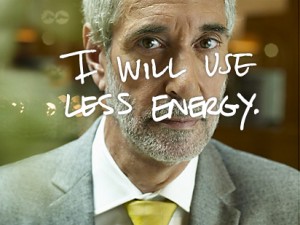Greening Big Oil?
Chevron is the latest oil company to try to prove it’s environmentally aware by supporting energy conservation. But this could be a tough sell.
Jul 31, 202067.3K Shares1.9M Views
Image has not been found. URL: /wp-content/uploads/2008/10/medialeavecar.jpgwww.willyoujoinus.com
While walking around Washington, it’s hard to miss all the large Chevron ads. They are at bus stops and in metro stations, and they feature “everyday people” promising to conserve energy. “I will carpool to work,” one person in the ad says. “I will take the golf clubs out of the trunk,” promises another. “I will leave the car at home more,” pledges a third.
And, in each one, Chevron vows it will conserve energy, too.
Illustration by: Matt Mahurin
Chevron launched its “I will” campaign last month in Washington, Houston and cities throughout California. The new ads continue the oil company’s “Power of Human Energy” ad campaign that began about a year ago. Through TV spots, print ads, billboards and a website called Will You Join Us, Chevron says it seeks to raise awareness about energy conservation and efficiency.
But exactly how green can an oil company claim to be? And will consumers buy its claims?
Chevron, America’s second largest oil company, with profits of $18.7 billion last year, isn’t the only oil producer spending millions to burnish its image. Like other big oil companies, it has switched gears from ignoring or denying climate change to announcing it role in combating this problem, oil experts say.
For example, if you’ve turned on the TV lately, you’ve probably seen a commercial like this from ExxonMobil:
Exxon, the country’s biggest oil company, with profits last year of $39.5 billion, recently launched its environmental-themed ad campaign. BP was perhaps ahead of this curve — for British Petroleum started rebranding itself as “Beyond Petroleum” in 2000.
Some experts say Chevron and all the other oil companies will have to work a lot harder to gain the trust of consumers, who are finally getting some relief at the pumps after gasoline prices hit $4 a gallon this summer. They say the companies will have to transform their actions, not just their images.
Chevron says it differs from the other oil companies because it invests in clean technologies and fuel efficiency. Those who study the oil industry assert that the company’s investment is minor when compared to its large profits.
www.willyoujoinus.com
But Kimberly Beman the Chevron spokeswoman said, “Between 2007 and 2009, Chevron has projected spending of more than $2.5 billion for alternatives, renewables and energy-efficiency services.” *
Beman also pointed out that, since 2000, Chevron Energy Solutions, a Chevron subsidiary that focuses on environmental issues, has developed hundreds of projects in energy efficiency and renewable energy.
“CES projects will help to reduce over a billion dollars in energy costs for customers,” Beman told The Washington Independent.
But a billion dollars spent over an unspecified period of time doesn’t exactly seem like a lot of money for a company that made a record $18.7 billion in profits last yearalone.
Steve Kretzmann, director of the nonpartisan organization Oil Change International, said that Chevron’s priority is cleaning up its image — and that speaks volumes about its credibility on conservation. “Chevron spends millions and millions on these ad campaigns,” said Kretzmann, “and then doesn’t devote hardly any amount of money to invest in renewable-energy technologies that could make a huge difference.”
Chevron spent$15 million last year on advertising to promote it’s green policies, according to Grist. This seems to be the norm among the big oil companies.
Exxon, for example, spent only 1 percent of its record-breaking annual profit last year on alternative energy, reportsABC News.
www.willyoujoinus.com
But Chevron spokeswoman Beman says her company isn’t like the other oil companies. “We feel we differentiate ourselves from our competitors to say conservation is key to our [mission],” she said. “I think it’s just an overall call to action that all of us are responsible. Chevron is taking the lead in opening this discussion.”Kalle Lasn, editor-in-chief of Adbusters Magazine, a non-profit that studies consumerism, finds this claim surprising. Until recently, he says, oil companies like Chevron have been “instrumental in delaying the debate we needed to have on climate change.”
“For years,” Lasn said, “[they were] trying to deny climate change and keep the business-as-usual scenario going.” James Hansen, director of NASA’s Goddard Institute for Space Studies and one of the world’s leading climate scientists, agrees with Lasn. In June, he testified before Congress:
“„Instead of moving heavily into renewable energies, fossil fuel companies choose to spread doubt about global warming, just as tobacco companies discredited the link between smoking and cancer.
“Then, just a few short years ago” Lasn said, “when it became quite obvious that they couldn’t deny climate change any longer, one by one they jumped on this [PR] bandwagon…and started painting themselves as the good guys.”
That’s why almost all big oil companies now have ads greenwashing themselves, Lasn said. It started with BP — originally British Petroleum — changing its logo in 2000 to a sun and referring to itself as “Beyond Petroleum.” BP talks aboutthis global branding strategy on its website.
Now, even ExxonMobil — a company known tohave given millions of dollars to groups denying global warming — has launched green ads.Are these costly PR campaigns working?
Lasn says they have potential. “A lot of people are totally hoodwinked by this,” he said. “There are millions of people out there who actually do fall for it, who are not aware of some of the history of these big oil companies.”
That’s what Chevron is counting on, Lasn says.
Green advertising can help companies shape their brand, says Lasn, because even large corporations care about public perception.
“[Oil companies] know the next time there is a financial crunch, like now, or if climate change veers out of control even more than it already has, then their survival depends on how the public perceives them,” he said.
TerraChoice, an environmental marketing firm that conducts advertising research, agrees that green advertising can be effective. Media consultant Kate Rusnak says consumers are happy to see so many businesses moving in a more sustainable direction. As a result, she said, “there has certainly been a huge rise in the amount of green advertising.” This could be why even oil companies are jumping on the bandwagon.
Still, not everyone says Chevron is winning on the public-perception front. “I don’t think that [this ad campaign] is particularly effective for consumers,” said Kretzmann of Oil Change International. “The industry knows it has an image problem.”
*Note: This article originally did not say how much Chevron spends on its alternative energy projects. A quote from the oil company detailing its projected budgets was added to the piece after posting.

Paula M. Graham
Reviewer
Latest Articles
Popular Articles


